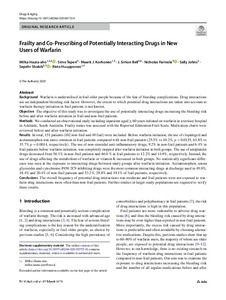Frailty and Co-Prescribing of Potentially Interacting Drugs in New Users of Warfarin
Risto Huupponen; Simo Teperi; Sepehr Shakib; Sally Johns; J. Simon Bell; Milka Hauta-Aho; Maarit J. Korhonen; Nicholas Farinola
Frailty and Co-Prescribing of Potentially Interacting Drugs in New Users of Warfarin
Risto Huupponen
Simo Teperi
Sepehr Shakib
Sally Johns
J. Simon Bell
Milka Hauta-Aho
Maarit J. Korhonen
Nicholas Farinola
Adis, Springer Science+Business Media
Julkaisun pysyvä osoite on:
https://urn.fi/URN:NBN:fi-fe2021042825262
https://urn.fi/URN:NBN:fi-fe2021042825262
Tiivistelmä
Warfarin is underutilised in frail older people because of the fear of bleeding complications. Drug interactions are an independent bleeding risk factor. However, the extent to which potential drug interactions are taken into account at warfarin therapy initiation in frail patients is not known.
The objective of this study was to investigate the use of potentially interacting drugs increasing the bleeding risk before and after warfarin initiation in frail and non-frail patients.
We conducted an observational study including inpatients aged ≥ 60 years initiated on warfarin in a tertiary hospital in Adelaide, South Australia. Frailty status was assessed with the Reported Edmonton Frail Scale. Medication charts were reviewed before and after warfarin initiation.
In total, 151 patients (102 non-frail and 49 frail) were included. Before warfarin initiation, the use of clopidogrel and acetaminophen was more common in frail patients compared with non-frail patients (25.5% vs 10.2%, p = 0.0135, 63.8% vs 35.7% p = 0.0014, respectively). The use of non-steroidal anti-inflammatory drugs, 9.2% in non-frail patients and 6.4% in frail patients before warfarin initiation, was completely stopped after warfarin initiation in both groups. The use of antiplatelet drugs decreased from 56.1% in non-frail patients and 66.0 % in frail patients to 12.2% and 14.9%, respectively. Instead, the use of drugs affecting the metabolism of warfarin or vitamin K increased in both groups. No statistically significant difference was seen in the exposure to interacting drugs between study groups after warfarin initiation. Acetaminophen, senna glycosides and cytochrome P450 2C9 inhibiting drugs were the most common interacting drugs at discharge used in 49.0%, 18.4% and 20.4% of non-frail patients and 53.2%, 29.8% and 19.1% of frail patients, respectively.
The overall frequency of potential drug interactions was moderate and frail patients were not exposed to warfarin drug interactions more often than non-frail patients. Further studies in larger study populations are required to verify these results.
Kokoelmat
- Rinnakkaistallenteet [19207]
